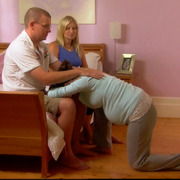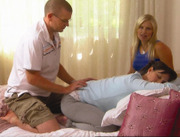Active birth with your birthing partner – get your partner into it! Hot tips for an active birth with your birthing partner
Top Tip One – Try the all fours position during the early stages of labour.
 The all fours position, during the early stages of labour, can really help to alleviate contraction discomfort. This pose can be done on the floor or the bed. It helps to encourage the baby into the anterior position so its spine swings to the front of your belly. It also relieves the pressure in the pelvis as gravity takes the weight away from your sacrum and coccyx (your lower spine)
The all fours position, during the early stages of labour, can really help to alleviate contraction discomfort. This pose can be done on the floor or the bed. It helps to encourage the baby into the anterior position so its spine swings to the front of your belly. It also relieves the pressure in the pelvis as gravity takes the weight away from your sacrum and coccyx (your lower spine)
This pose is particularly helpful for women who are labouring with a posterior lying baby. The all fours position not only encourages the baby to anterior position, it can also help alleviate the back pain that is associated with the posterior position.
The all fours position can also be used in the second stage of labour.
Bonus Tip!
Try doing this pose throughout your pregnancy, particularly in the last trimester, as it is an excellent way to encourage anterior lying babies.
Top Tip Two – Learn to use pelvic rotations to dissipate contraction discomfort.
 Try pelvic rotations during labour to increase your comfort either during contractions in the first stage or between contractions in the second stage. There are two ways to do pelvic rotations.
Try pelvic rotations during labour to increase your comfort either during contractions in the first stage or between contractions in the second stage. There are two ways to do pelvic rotations.
- Kneel on the floor or up on the bed with your knees hip width apart. You can kneel on a pillow or floor mat for comfort.
- Or, kneel with one knee on the floor and one knee bent so the foot is on the floor (see picture). Then lean into the bed a ball or your partner.
From whichever position you are in, you then do slow circling motions with the hips. This will help to dissipate the discomfort as a contraction grows. In this pose gravity also helps to move the baby into a better position to be born.
Top Tip Three- Relax using the child’s pose.
 The child’s pose can be done on the bed or the floor. Take the knees wider than the belly, big toes touching and sit back onto your heels. You can place your arms up on the bed, on your partner, on stacked pillows or on a ball. In this position gravity also helps move the baby down onto the dilating cervix.
The child’s pose can be done on the bed or the floor. Take the knees wider than the belly, big toes touching and sit back onto your heels. You can place your arms up on the bed, on your partner, on stacked pillows or on a ball. In this position gravity also helps move the baby down onto the dilating cervix.
Get your partner into it!
Your birthing partner can be involved here by massaging your back, applying heat packs or holding a TENS machine for you if you are using one.
Top Tip Four – For the later stages of labour try using the deep Squat position.
 The deep squat position is great for late in the first stage of labour as it helps to widen the pelvic diameter bringing the babies head down onto the dilating cervix. You can do this position on the bed or the floor. During second stage a deep squat can help open the pelvis and help facilitate the baby’s birth.
The deep squat position is great for late in the first stage of labour as it helps to widen the pelvic diameter bringing the babies head down onto the dilating cervix. You can do this position on the bed or the floor. During second stage a deep squat can help open the pelvis and help facilitate the baby’s birth.
If you’re up on the bed, raise the back of the bed to 90 degrees supporting the back, then bend the knees and place the feet flat on the bed.
Get your partner into it!
Lean back onto your partner who is sitting on a chair or the ball and squat down with the knees wide.
Top Tip Five: To help with contractions, visualise your end goal by focusing on something special.
 When you are preparing your baby’s birth, consider buying something special for the baby to wear after it’s born. This may be a little pair of socks or a little suit. It can be anything that you feel is beautiful. You can look at it every now and then during your labour and this will help you focus on the end goal.
When you are preparing your baby’s birth, consider buying something special for the baby to wear after it’s born. This may be a little pair of socks or a little suit. It can be anything that you feel is beautiful. You can look at it every now and then during your labour and this will help you focus on the end goal.
Zoe, a mother of four and a teacher of both prenatal and baby yoga says: “Understanding and learning these poses will empower pregnant women with knowledge and understanding of active birth positions.”


These are great positions to remember when in labour. I have found that the right position can really help with my ability to ‘let go’ in labour and to trust that my body and my baby are working together. The right position aids a smooth, efficient birth.